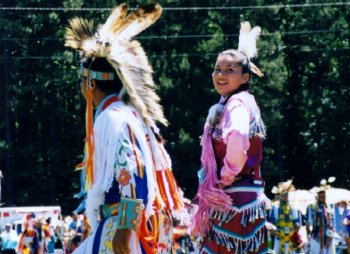LITR 4332: American Minority
Literature

Student Poetry Presentation 2004
"Matinee"
Susan
Clements
UA, page 73

Biographical Information:
Susan Clements was born in 1950
in Livingston Manor, New York (Spratlin). Clements is of Blackfeet, Mohawk,
Seneca, and European heritage. She has written The Broken Hoop, published
in 1988, as well as In the Moon When the Deer Lose Their Horns, published
in 1993 (UA 387). She went to Binghamton University (Spratlin). Binghamton is
located in New York, as is the Seneca Nation. The Mohawk and Seneca Nations are
part of The Six Nations of the Iroquois. The Six Nations are located in the
northern U.S. and in Canada. Seneca Indians.com recognizes Clements as a Seneca
Indian poet. The Blackfeet Nation is located in Montana, so even though Clements
is not full, or pure blood, the three Indian Nations are fairly similar to one
another in their locations.
Course Objectives:
Objective 4: To register
the minority
dilemma of assimilation or
resistance—i. e., do you fight or
join the culture that oppressed you? What
balance do minorities strike between economic
benefits and personal or cultural
sacrifices? In general, immigrants assimilate, while minorities (esp.
African Americans) remain distinct.
In Matinee: Takes on a twist to Obj. 4. The
speaker is fighting to assimilate into the dominant culture.
Literary Term:
From The Bedford Glossary of Critical and Literary
Terms:
Representation: The use of one thing to stand or
substitute for another through some kind of signifying medium. New Historians
have recently given the word a more specific meaning, and use representation to
refer to the symbolic constructions of a given society in a specific era. New
Historians view representations as both products of and the means of propagating
the culture’s prevailing ideologies and power relations. In other words,
representations maintain the status of the dominant class by re-presenting the
belief systems and preserving the institutions upon which their status and power
depend upon (407).
My Interpretation:
This poem is very straightforward
and prose like, so I almost forgot I was reading a poem and not a short story. I
do not believe there are any lines that are difficult to understand, so I will
just discuss what I picked up from reading it. I think the poem is a sort of
social commentary on society and its representation of American Indians.
Clements was a kid in the 50’s and 60’s, and the poem is dated as being back
then. (You can’t go to the movies now for a quarter.) Now in 2004 I think
American society is much more interested in being “politically correct”.
Although modern movies such Disney’s Pocahontas and Dances With
Wolves may portray American Indians in a stereotypical fashion, the
stereotype is a good one, as opposed to savage and nasty. The young speaker of
the poem it seems has completely assimilated into the dominant culture, and is
somewhat traumatized my learning she is part of a shunned minority group. I
believe the author is pointing out the injustice of the dominant culture’s
representation of American Indians.
Questions:
- Lines
13 and 14 are a problem for me: “to pretend tameness when your own blood
ran wild with foxes and invisible deer.” The first time I read this I
though she was just a tomboy, until on the second page I realized she had
American Indian blood in her. These two lines seem to conform to the modern
stereotype of American Indians. (I can just picture Disney’s Pocahontas
running through a forest with animals singing about how she loves nature.)
If the author is interested in confronting the dominant culture’s negative
stereotype of her minority’s culture, then why does she seem embrace the
positive, although oftentimes unrealistic, stereotype?
In Geri Spratlin’s 2002
interpretation of the poem, Geri stated “The speaker dislikes the game because
where the friend pretends to be in a domestic situation, even though the Indian
child sees herself closer to nature, she assimilates into the dominant
precept.” I am wondering then if maybe the author likes the stereotype of
American Indians being close to nature, and all little American Indian girls
being Pocahontas-like?
- The
only line I believe that could be up for interpretation is the last line,
“You glitter as you fall”. My interpretation is she is glittering
because she is pretending to be a white princess, and she is falling because
it is only pretend. Does anyone else have any interpretations or comments?
- Does
the author writing in this “free-verse” or “prose-poem” style have
any impact on the poem and the meaning it conveys?